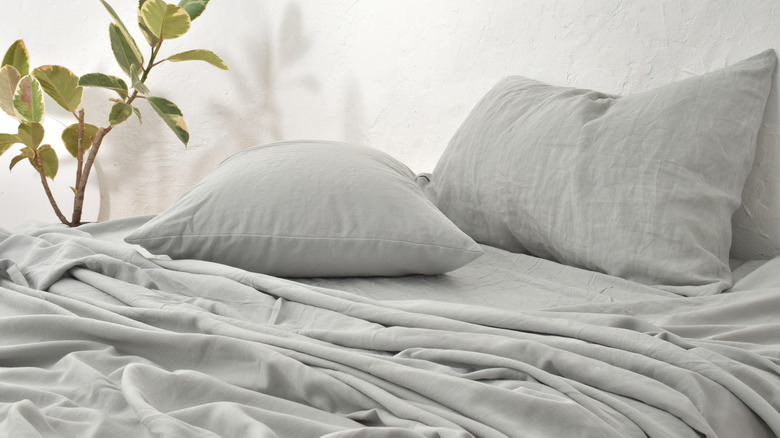It's Time To Address The Annoying Problem With Those Trendy Linen Sheets
There are many reasons to think about upgrading to linen sheets. For starters, linen is a sustainable natural material that's durable enough to hold up to repeated washings. Linen sheets allow air to flow through them easily and can absorb water, up to 20% of their weight, without getting damp, making them breathable and moisture-wicking enough for warmer weather. Their effortlessly elegant, and their natural look definitely doesn't hurt, either. But linen sheets aren't without their issues. For those new to sleeping on them, the amount of shedding they do can be seriously frustrating. Add in their high-end price and how rough they can feel, and it's easy to see why some people think twice about trendy linen sheets.
It's important to consider everything you should know before buying your next set of sheets to make the most informed decision, which starts with their material. Linen is a woven fabric made from long strands of the flax plant. It is medium-weight and features hollow fibers that provide natural insulation to keep you comfortable in all weather. Flax fibers are naturally coarse, so sheets and other items made from linen can have a slightly scratchy texture. This roughness is part of the reason why they're so durable. However, caring for your linen sheets in the right way can not only soften them, but also help reduce shedding, so you can get a more restful night's sleep.
Shedding and other issues with linen sheets
While linen sheets' tendency to shed is certainly annoying, it is due to linen's status as a natural fiber. Flax fibers of varying lengths and widths are woven together to create linen, but it is not as tightly woven as cotton. As a result, the shorter fibers often come loose and shed from the sheets. In most cases, the shedding decreases over time. The weave and quality of the sheets can play a role, though. You'll see more shedding in sets with a looser weave, as well as sheets made of lower-quality linen.
In addition to the shedding, some people are taken aback by how scratchy or itchy linen sheets feel. Typically, they only have this texture when you first purchase them. Linen's looser weave, compared to fabrics like cotton, allows air to flow through it for better breathability, but it also gives it a rougher texture. Flax fibers are also thicker and stiffer, which contributes to the scratchy feeling. Linen sheets that are treated with heavy starch or don't undergo pre-washing tend to be the scratchiest.
Considering those issues, you may wonder why linen sheets are so expensive. In fact, a queen-size set of high-quality cotton sheets generally ranges from $150 to $250, while linen sheets of the same size usually cost between $300 and $600. Unfortunately, making linen is a long, labor-intensive process, which requires a considerable amount of work to be done by hand.
How to stop shedding and soften linen sheets
Since shedding typically occurs when linen sheets are new, washing your sheets a few times can remove many of their loose fibers. However, be sure to use cold or lukewarm water because heat can actually weaken and loosen the fibers further. Opt for a mild laundry liquid detergent or a formula specifically labeled for delicate fabrics. It's always best to wash linen sheets on their own and not to overload the washer because the friction from brushing up against other items in your wash can cause more shedding. And, because of the heat issue, you're also better off air-drying linen sheets whenever possible. But, if you must throw them in the dryer, use the lowest heat setting and toss in a couple of dryer balls, to help increase the softness.
Taking these steps to wash linen can help soften your bed sheets. If they're still feeling a little too scratchy and itchy, though, try adding a half cup of baking soda to each load to help relax the fibers. It also has the added bonus of neutralizing odors, so your sheets will feel soft and smell fresh.


